China’s Export Resilience Amid Rising Tariffs: A Strategic Triumph
Introduction
April 2025 marked a pivotal moment in global trade as China’s export sector defied expectations despite escalating U.S. tariffs. While many anticipated a slowdown, China’s exports surged by 8.1% year-on-year—far exceeding the projected 1.9% growth. This unexpected resilience reveals not just short-term maneuvers but a deeper strategic recalibration. How did China turn tariffs into a mere speed bump rather than a roadblock? The answer lies in a mix of market agility, policy ingenuity, and global trade diversification.
The Anatomy of China’s Export Resilience
Frontloading: Beating the Tariff Clock
One immediate driver of April’s export spike was the race to ship goods before higher U.S. tariffs took effect. Businesses, both Chinese and foreign, accelerated orders to avoid cost hikes, creating a temporary but significant boost. This tactic isn’t new—similar surges preceded past tariff deadlines—but its effectiveness underscores the precision of China’s supply chain logistics.
Manufacturing Agility Against the Odds
Even with manufacturing activity hitting a 16-month low, China’s factories adapted swiftly. Industries like electronics and machinery, which dominate exports, streamlined production to meet pre-tariff demand. The ability to scale operations up or down in response to external pressures highlights a key strength: China’s manufacturing sector isn’t just vast; it’s nimble.
Policy Levers: More Than Just Stimulus
Behind the scenes, targeted government policies played a critical role. Subsidies for exporters, tax rebates, and streamlined customs procedures provided a cushion against tariff impacts. More subtly, infrastructure investments—like expanding port capacities—ensured that the surge in shipments didn’t bottleneck. These measures didn’t just react to tariffs; they preemptively fortified the export ecosystem.
Sectoral Divergence: Winners and Losers
The U.S. Market Squeeze
Exports to the U.S. plummeted by 21%, a direct hit from Trump’s new 10% blanket tariff. Industries like consumer electronics and textiles, already grappling with earlier tariffs, bore the brunt. Yet, this wasn’t just a story of loss. Some Chinese firms absorbed partial tariff costs to retain market share, while others rerouted goods through third countries like Vietnam—a tactic that blunted but didn’t eliminate the damage.
Diversification Pays Off
While U.S. exports faltered, shipments to ASEAN, the EU, and Africa surged. For instance, electric vehicle exports to Europe rose by 34%, capitalizing on both China’s competitive pricing and Europe’s green transition. This shift wasn’t accidental; it reflected years of strategic trade agreements and market cultivation. The lesson? Overreliance on any single market is risky, but China’s multi-pronged trade strategy provided a lifeline.
Global Ripples: Beyond China’s Borders
The U.S. Trade Deficit Paradox
Oddly, the U.S. trade deficit hit a record high in March 2025, as American businesses stockpiled imports ahead of tariffs. This irony reveals a flaw in protectionist logic: tariffs can disrupt trade flows but don’t automatically rebalance deficits. Instead, they often lead to inflationary pressures—a reality already pinching U.S. consumers.
Supply Chain Realignments
China’s resilience forced competitors to rethink their playbooks. India and Southeast Asia, often touted as “China alternatives,” struggled to absorb displaced manufacturing due to infrastructure gaps. Meanwhile, China’s Belt and Road Initiative (BRI) deepened ties with emerging markets, ensuring demand for its exports even as Western markets tightened.
Conclusion: The New Rules of Trade Warfare
China’s April 2025 export performance wasn’t just a statistical blip; it was a masterclass in economic adaptation. Key takeaways:
– Agility over rigidity: Frontloading and manufacturing flexibility turned tariffs into manageable disruptions.
– Diversification as armor: Reducing dependency on the U.S. market mitigated systemic risks.
– Policy as a strategic tool: Proactive subsidies and logistics investments amplified resilience.
The broader implication? Trade wars in the 2020s are no longer zero-sum games. China’s response proves that with the right mix of tactics, even aggressive tariffs can be outmaneuvered—setting a precedent for how economies might navigate an era of rising protectionism. The question now isn’t whether China can withstand trade shocks, but how its strategies will reshape global commerce in the years ahead.











